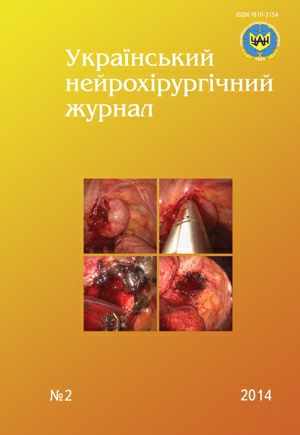U-implants of Ukrainian production at lumbar spine stenosis (making and clinical application)
DOI:
https://doi.org/10.25305/unj.51299Keywords:
spinal stenosis, interspinous fixation, U-implant, neurogenic claudicationAbstract
The purpose. To evaluate the possibility of U-implants of Ukrainian production application at treatment of lumbar spine stenosis.
Material and methods. Numerous studies (chemical, microscopic, phase analysis) of alloy and strength characteristics of Coflex implant were conducted that gave a possibility to create and successfully conduct clinical trials of new Ukrainian U-implant, characterized from their foreign counterparts both in composition and form, and also to obtain a certificate of state registration.
Results. Chemical analysis showed that the product, according to the classification adopted in the world, corresponds to alloy Grade 5, or Ti-6Al-4V, the analogue of the alloy BT6. This alloy application provides better strength characteristics of the product while maintaining it’s plasticity. Application of the Ukrainian implant in clinical practice in 11 cases allowed to reach full recourse of clinical symptoms in the early postoperative period.
Conclusions. Application of a new Ukrainian U-implant after interspinous fixation and preliminary decompression is an effective method for treatment at lumbar spine stenosis.
U-implant of Ukrainian production has a number of positive technical features that improve it’s characteristics.
References
1. Schlegel J, Smith J, Schleusener R. Lumbar Motion Segment Pathology Adjacent to Thoracolumbar, Lumbar, and Lumbosacral Fusions. Spine. 1996;21(8):970-981. [CrossRef]
2. Molina M, Wagner P, Campos M. Spinal lumbar stenosis. An update. Rev. Med. Chil. 2011;139:1488–1495. [CrossRef]
3. Verbiest H. Results of surgical treatment of idiopathic developmental stenosis of the lumbar vertebral canal: a review of 27 years experience. J. Bone Joint Surg. Br. 1977;59:181–188. [PubMed]
4. Tuite G, Stern J, Doran S, Papadopoulos S, McGillicuddy J, Oyedijo D, Grube S, Lundquist C, Gilmer H, Schork M. Outcome after laminectomy for spinal stenosis. Part I: Clinical correlations. J. Neurosurg. 1994;81(5):699-706 [CrossRef]
5. Kanamiya T, Kida H, Seki M, Aizawa T, Tabata S. Effect of Lumbar Disc Herniation on Clinical Symptoms in Lateral Recess Syndrome. Clinical Orthopaedics and Related Research. 2002;398:131-135. [CrossRef]
6. Kaner T, Ozer A. Dynamic Stabilization for Challenging Lumbar Degenerative Diseases of the Spine: A Review of the Literature. Advances in Orthopedics. 2013;2013:1-13. [CrossRef]
7. Li CD, Sun HL, Lu HZ. Comparison of the effect of posterior lumbar interbody fusion with pedicle screw fixation and interspinous fixation on the stiffness of adjacent segments. Chin Med J (Engl). 2013;126(9):1732-1737. [PubMed]
8. Nachanakian A, El Helou A, Alaywan M.The interspinous spacer: a new posterior dynamic stabilization concept for prevention of adjacent segment disease. Adv Orthop. 2013;2013:637362. [CrossRef]
9. Wilke HJ, Drumm J, Häussler K, Mack C, Kettler A. Biomechanics of interspinous spacers. Orthopade. 2010 Jun;39(6):565-572. [CrossRef]
10. Serhan HA, Varnavas G, Dooris AP, Patwadhan A, Tzermiadianos M. Biomechanics of the posterior lumbar articulating elements. Neurosurg Focus. 2007 Jan 15;22(1):E1. [PubMed]
11. Davis R, Errico T, Bae H, Auerbach J. Decompression and Coflex Interlaminar Stabilization Compared With Decompression and Instrumented Spinal Fusion for Spinal Stenosis and Low-Grade Degenerative Spondylolisthesis. Spine. 2013;38(18):1529–1539. [CrossRef]
12. Kuklo TR, Potter BK, Ludwig SC, Anderson PA, Lindsey RW, Vaccaro AR. Radiographic measurement techniques for sacral fractures consensus statement of the Spine Trauma Study Group. Spine. 2006;31(9):1047–1055. [CrossRef] [PubMed]
13. Borisova EA, Bochvar GA, Brun MYA [et all]. Metallografiya titanovykh splavov. [ Metallography titanium alloys.] Moscow: Metallurgiya; 1980. Russian.
14. Lutjering G, Williams J. Titanium. Berlin:Springer; 2003.
15. Tumanov AT., editor. Aviatsionnyye materialy: t.5. Titanovyye splavy. Moscow: VIAM; 1973. Russian.
16. Il'in AA, Kolachev BA, Pol'kin IS. Titanovyye splavy. Sostav, struktura, svoystva. [Titanium alloys. The composition, structure and properties]. Moscow:VILS-MATI; 2009. Russian.
17. Il'in A, Skvortsova S, Mamonov A., Karpov V. Production of medical implants from titanium base materials. Metally. 2002;3:97–104. Russian. [eLIBRARY.ru]
Downloads
Published
How to Cite
Issue
Section
License
Copyright (c) 2014 Yuriy Pedachenko, Sergey Sheykin, Pavel Markovskiy, Elena Krasilenko

This work is licensed under a Creative Commons Attribution 4.0 International License.
Ukrainian Neurosurgical Journal abides by the CREATIVE COMMONS copyright rights and permissions for open access journals.
Authors, who are published in this Journal, agree to the following conditions:
1. The authors reserve the right to authorship of the work and pass the first publication right of this work to the Journal under the terms of Creative Commons Attribution License, which allows others to freely distribute the published research with the obligatory reference to the authors of the original work and the first publication of the work in this Journal.
2. The authors have the right to conclude separate supplement agreements that relate to non-exclusive work distribution in the form of which it has been published by the Journal (for example, to upload the work to the online storage of the Journal or publish it as part of a monograph), provided that the reference to the first publication of the work in this Journal is included.









